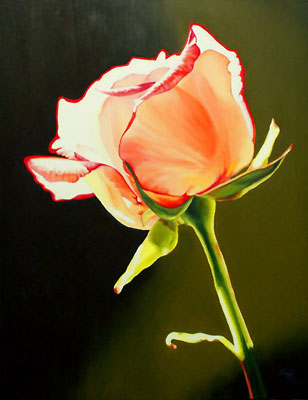 Artisan Water Soluble Oils from Winsor and Newton are recommended. The particular pigments named here are Artisan brand, however, the more expensive brands of water-mixable oils are sometimes more creamy out of the tube. Artisan give you a good starting price point, and you can always try other brands later if you like.
Artisan Water Soluble Oils from Winsor and Newton are recommended. The particular pigments named here are Artisan brand, however, the more expensive brands of water-mixable oils are sometimes more creamy out of the tube. Artisan give you a good starting price point, and you can always try other brands later if you like.
This particular brand is a good price point, but I have found that I nearly always want to add some of the Artisan Fast Drying Medium to ensure that it is a creamy texture and flows well off the brush. Stir it in thoroughly on the palette.
Health Note: Some pigments are toxic, but not if used as intended. Specifically; if you find you are frequently getting paint on your hands, it is wise to use a barrier cream before painting. Most cost effective – check the baby department at the drug store, and pick up a tube with the word “silicone” on it. Make sure it is dry on your hands before you touch your canvas.
Essential Paints
|
Optional Frequently-Used Paints
*In oils, it can be difficult to find specific shades of Phthalo Blue and Phthalo Green, so simply buy whatever ‘shade’ is available. Highly recommended: Artisan Oils Fast Drying Medium |
Additives
Turpentine is NOT needed, and is not allowed in class. “Fast Drying Medium” is highly recommended for Artisan Oils. This is the only medium I use – some of the other mediums take many months to dry! Also important: do NOT add water to these paints while painting with them. This loses the integrity of the paint risking crackling as it dries. Water is used for clean up only. Be careful when washing your brushes that you don’t accidently bring water into the paint on your palette. Dry the brushes well on a paper towel before dipping back into the paint.
Brushes and Palette Knives
I prefer the white or brown synthetic square brushes. Recommended are: 4 synthetic 1 cm. square brushes, plus a couple of 1.5 cm square brushes are a good start. For details, two short round white synthetic brushes are useful. You will also need a 2.5 cm (that’s 1 inch) square soft synthetic brush for blending, and a medium sized palette knife with diamond shaped tip for painting, and longer bladed knife for mixing.
Note: Oil painters often buy extras of their favourite brushes (6 or more) so they don’t have to clean brushes as often. Better quality synthetic brushes, though more expensive, will last longer and not shed into your painting! I really dislike the traditional oil painting hog bristle brushes because they do not hold their shape and tend to shed.
Canvas
The cheapest way to buy a good quality canvas is from the roll at the art store. Be sure to buy the pre-gessoed one, and save that step. You can then cut them into sheets the size you want to work on. For class the largest we work is 16″ x 20″, and you may want some smaller as well. You will need a corrugated plastic board (poster board), cut to a couple of inches larger than your canvas sheet, to tape your canvas pad sheet onto. This board is essential for oil painters. It makes it much easier to work on, and to transport. (Art supply stores sell these boards.) If you prefer painting on pre-stretched canvas or primed board that’s fine too, but the canvas sheet is still recommended for exercises or trying your colours. For exercises, just buy a small amount and cut it into 10″ x 12″ sheets.
Miscellaneous Supplies
Any white palette (I use wax paper over a white porcelain plate for easy clean up), 1 sheet of graphite paper (dark gray or black), soft pencil (4B), HB pencil, pencil sharpener, sticky tac or hold-it (better than a kneadable easer), ball point pen, large plastic container for water, shop towels (see note below), small piece of hand soap, 3 ring binder for notes, masking or painter’s tape, 12″ ruler, scissors, and photos for reference (inspiration!)
About Paper Towels
Buy the blue shop towels from any hardware store. These are much more absorbent, and can be rinsed out at the end of the painting session and reused multiple times before throwing them away. Much better for the environment, and more pleasant to work with than paper towels.